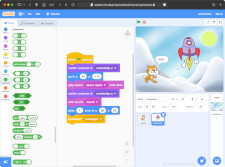Block-Based Coding
Block-based coding is a type of programming that uses a visual drag-and-drop interface instead of a source code editor. By connecting various blocks, novice developers can write programs without knowing a programming language.
Individual blocks within a block-based coding project represent commands, such as move and turn, and clauses, such as when, while, and if then statements. A string of blocks can be attached to one or more objects, such as an image or sprite. For example, a basic program may display a cat sprite that moves the cat to the center of the canvas and plays a "meow" sound when clicked. The program would require the following three blocks, attached to the cat object.
- (clause)
- (command)
- (command)
More complex programs include multiple sprites that interact with each other. With enough blocks, it is possible to create detailed animations or interactive games.
Block-based coding is primarily used as a learning tool for beginning programmers. It has a lower barrier to entry and provides an accessible introduction to software development. For many students, block-based coding is a simple, visual way to learn programming concepts.
 Test Your Knowledge
Test Your Knowledge